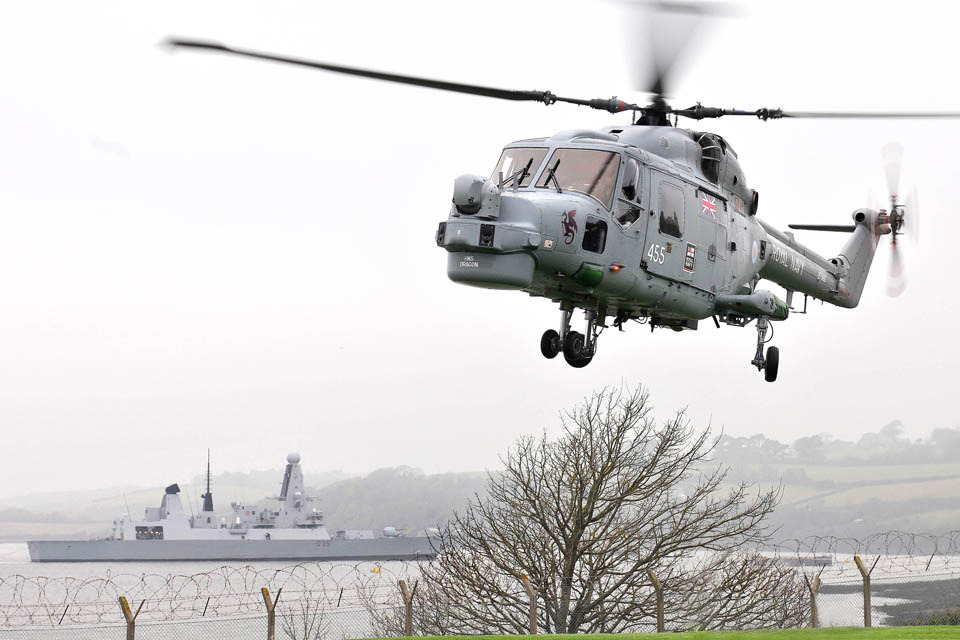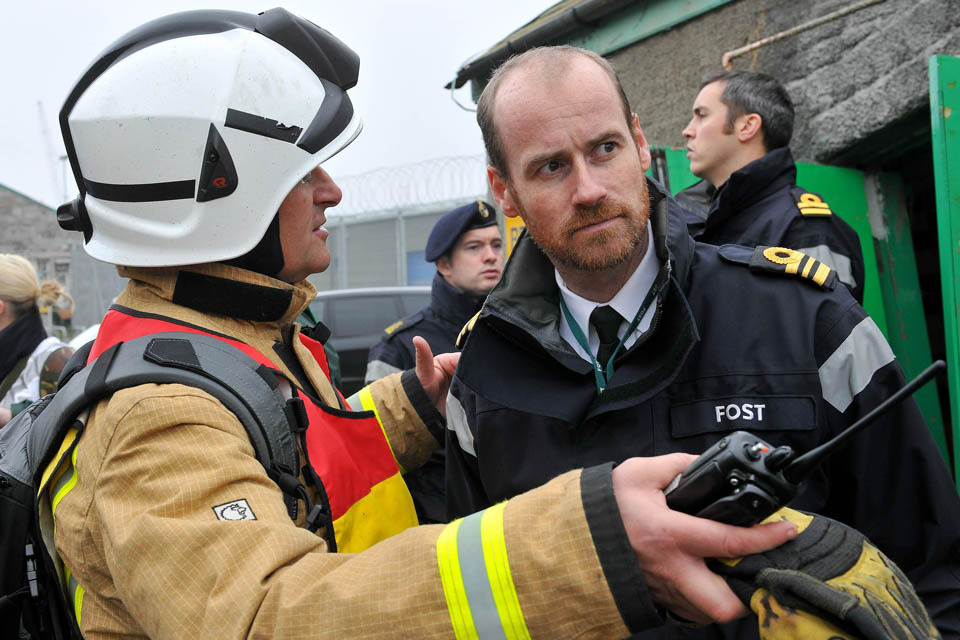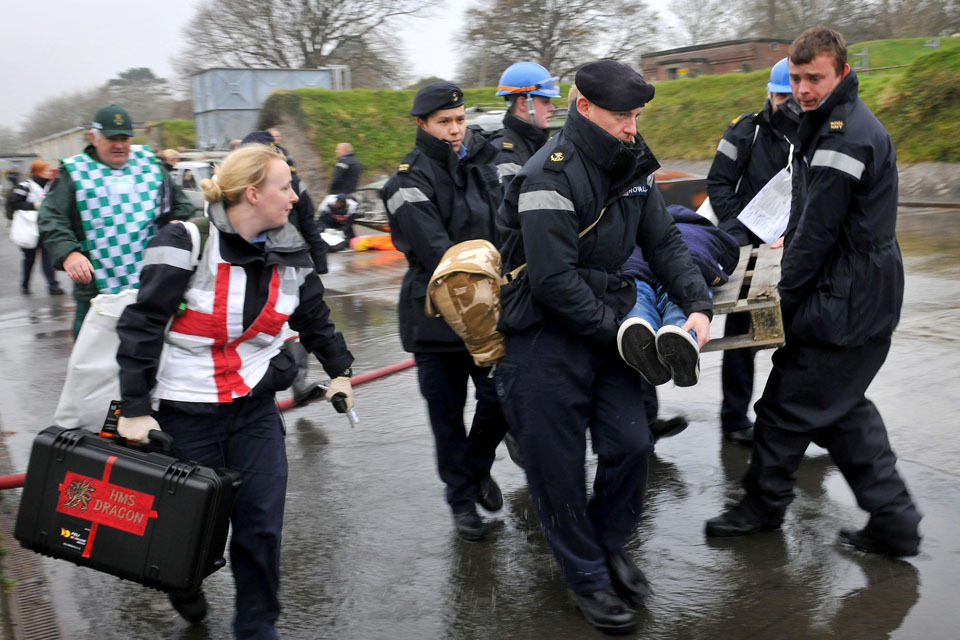HMS Dragon prepares for civil emergency
The crew of the latest of the Royal Navy's most advanced warships, HMS Dragon, have been rehearsing how to help in a civilian emergency.

Naval medics from HMS Dragon and Welsh Ambulance Service personnel deal with a 'casualty' during a Military Aid to the Civil Community exercise [Picture: Leading Airman (Photographer) Martin Carney, Crown Copyright/MOD 2012]
The latest of the Royal Navy’s Type 45 destroyers is in the South West of England training to become fully operational and ready to be deployed.
The ship, which has some of the world’s most sophisticated and accurate weapon, sensor and electronic warfare technology on board, is training under the Plymouth-based Flag Officer Sea Training organisation. For several weeks the ship is rehearsing wide-ranging skills from fighting wars at sea to providing humanitarian aid.
Humanitarian aid, involving going to the aid of civilian authorities, can include sending a warship to the scene of natural disasters (such as a volcanic eruption) or a man-made event like a war where civilians need evacuating; recent examples being when the Royal Navy helped evacuate residents from Libya and Lebanon.
In a rehearsal of the UK’s civil emergency contingency plan, Operation Resilience, HMS Dragon (affiliated to Cardiff in Wales) moored off a mock village in HM Naval Base Devonport in Plymouth which represented the isolated Flat Holm Island in the Bristol Channel.
The island had suffered a gas explosion, followed by the crash of a helicopter on the island sent to rescue birdwatchers trapped in the blown-up building.

HMS Dragon's own Lynx helicopter was sent in to take the worst of the injured to a stand-in hospital in Cardiff or back to the ship [Picture: Leading Airman (Photographer) Martin Carney, Crown Copyright/MOD 2012]
The ship’s own helicopter was sent in to take the worst of the injured to a stand-in hospital in Cardiff or back to the ship, and the multi-skilled crew were deployed to firefight, tend to casualties and conduct search and rescue under the command and direction of South Wales Police, South Wales Fire and Rescue Service and the Welsh Ambulance Service.
Lieutenant Commander John Fitzpatrick, the ship’s Executive Officer (second-in-command), was the ship’s captain’s representative ashore at the disaster nerve-centre in a makeshift building. He said:
The ship can be deployed anywhere and at any time in the world according to the UK Government’s requirements. This includes responding to military taskings and civil emergencies and conflicts.
He added:
As a Cardiff-affiliated ship we are exercising with South Wales civil authorities such as the emergency services and Cardiff City Council.
This gives us all a rare chance to rehearse emergency response. In this case we are making life difficult for ourselves by simulating injuries to birdwatchers trapped by a gas explosion on an uninhabited island where there is no community and, therefore, no hospital or emergency services.

A member of the South Wales Fire and Rescue Service discusses options with a member of the Flag Officer Sea Training organisation [Picture: Leading Airman (Photographer) Martin Carney, Crown Copyright/MOD 2012]
HMS Dragon has therefore been sent in and we are effectively another emergency service, but with multiple skills on board. Coming in from the sea on a remote island we can be first on the scene before the established emergency services and in this case are acting as an interim medical ship before onward transport to a hospital on the mainland.
Gareth Davies of the Welsh Ambulance Service assisted the Royal Navy’s medical teams as they treated casualties in the crashed helicopter. He said:
This is a great opportunity to share expertise with the Navy. We can mutually learn from each other.
Warrant Officer Dai Charles (HMS Dragon’s Executive Warrant Officer) co-ordinated the ship’s rescue teams. He said:
All sailors have various jobs on board and among them are emergency roles like firefighting and medical. Warships have to be self-contained when hundreds of miles from land.
This is ideal for emergency response and there is nothing better than working with the professionals in their fields to sharpen your skills. Once the sailors are off the ship and on land they are out of their normal environment, but they soon get into the swing of it under pressure and are responding very well.

Naval medics from HMS Dragon carry a 'casualty' away from the scene of the accident [Picture: Leading Airman (Photographer) Martin Carney, Crown Copyright/MOD 2012]
In overall command of the emergency is Inspector Steve Clarke of South Wales Police. His bronze-level command and control headquarters in a basic hut was a whirlwind of activity. He said:
It is a massive honour to have such a fantastic valuable asset as a Royal Naval warship and crew at our disposal. Exercising together gives us a valuable insight into the logistical support and capability of the Navy in a military aid scenario. The uniformed services are all dovetailing well.
HMS Dragon is due to undertake her training at sea off Devon and Cornwall as the next stage of operational training. Then she will help play an important part in allowing the Royal Navy to protect the UK’s interests worldwide.
HMS Dragon is one of six Type 45 destroyers, the most advanced warships the UK has ever built. Their Sea Viper missiles can knock out flying targets up to 70 miles (113km) away.